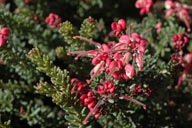In Flower This Week
A weekly news sheet prepared by a Gardens' volunteer.
Numbers before each plant refer to temporary IFTW labels in the gardens.
Numbers in square brackets [ ] refer to garden bed Sections. Plants in flower are in bold type.
View past issues of 'In Flower This Week'.
14 May 2014
Grevillea lanigera click for larger image |
We will walk to the Rock Garden today, first taking the path at the rear of the café.
- On you right is the standard grevillea Grevillea bipinnatifida ‘Jingle Bells’ [Section 124], with stiff, prickly, divided foliage and orange-red racemes of flowers.
- Further on your right is a small tree with fine linear foliage, Banksia spinulosa var. spinulosa [Section 109], with pale yellow flowers with styles that turn rusty red as they mature. It is a tall shrub or small tree that grows along the east coast of Queensland and New South Wales.
- On your left is Acronychyia littoralis[Section 114], a small rainforest tree with beautiful shiny leaves and creamy white scented clusters of flower. It is known as the Scented Acronychia or Beach Acronychia and grows naturally in northeastern New South Wales and a few areas in adjacent Queensland.
- Turn right to the Rock Garden past the Wollemi Pines. Enter up the steps to your left to see Grevillea lanigera [Section 15c], a low bush or groundcover of grey-green close foliage with pink and cream flowers.
- Also on your left is Banksia integrifolia subsp. integrifolia [Section 15c] or Coast Banksia, a scrambling mass of dark green silver-backed foliage and plenty of yellow upright flower heads.
- On your right is Correa ‘Ivory Bells’ [Section 15d], with dark green foliage and masses of cream bell flowers that are much loved by birds and bees.
- Also on your right is Banksia spinulosa ‘Honey Pots’ [Section 15d], a neat compact mid-sized shrub with fine silver-backed linear foliage and orange flower heads with rusty red styles.
- Grevillea manglesii subsp. ornithopoda[Section 15d] or Birds-foot Grevillea is a large bush on your right with fine grey-green foliage and terminal heads of white powderpuff flowers.
- Commersonia magniflora [Section 15g] is a small bush of oblong grey foliage and pink five-part flowers. Turn back along the path now and take the next left.
- On your left is a small vase-shaped bush of grey-green foliage with purple flowers resembling those of a potato. This is Solanum orbiculatum subsp. orbiculatum [Section 15g], which can also be seen in the Red Centre Garden. Cross the small plank bridge and bear right, then left to see on your left-hand side Dampiera sylvestris [Section 15l], a small bush with green foliage and bright blue flowers. The genus is named for William Dampier, an English sea captain and scientific observer.
- Go right down the steps to see on your left Alyogyne ‘West Coast Gem’ [Section 15r], a tall bush with coarse, lobed foliage and masses of large mauve ‘hibiscus’ flowers which open for a short period only but are prolific.
- On your right is Correa pulchella ‘Pink Mist’ [Section 15s], a small neat bush with pale pink bells. This cultivated variety (cultivar) was selected for its compact habit and flower colour. It came from a wild population of Correa pulchella on the southern Yorke Peninsula in South Australia, and was selected by G.R.O’Brien of Tea Tree Gully.
- Correa pulchella [Section 15s] further on the right is the species from which the cultivar above was selected. It is small evergreen shrub, endemic to South Australia.
- Go down the steps, past the waterfall and on your left is Guichenotia ledifolia [Section 4], a neat bush with soft grey foliage that contrasts prettily with its dusky pink maroon-centred bell flowers. It is endemic to Western Australia.
Rosalind Walcott
![Director of National Parks [logo]](../../../../images/dnp_90px.gif)







